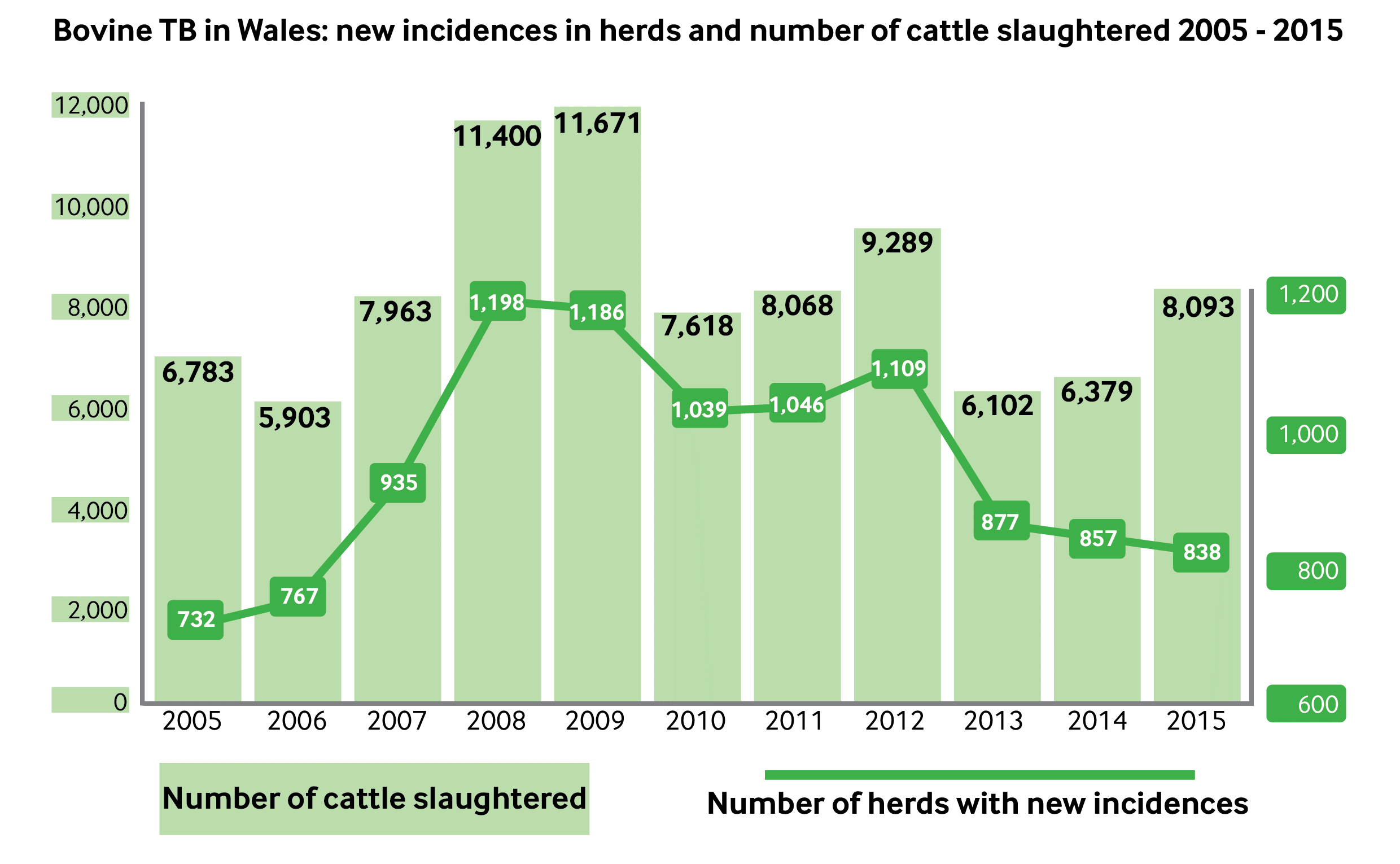The Cabinet Secretary for Environment and Rural Affairs will set out the Welsh Government’s approach to Bovine TB eradication in a statement to Plenary on 18 October 2016.
Due to its significant impact on animal welfare, farmer welfare and farm business viability, tackling Bovine TB (bovine tuberculosis) is a priority for the agriculture industry in Wales. In 2011, the UK Government’s Department for Environment, Food and Rural Affairs (Defra) estimated the cost of Bovine TB breakdown to be £30,000 per herd.
This blog post provides some background on the disease, its prevalence in Wales, and how the Welsh Government has sought to tackle it until now.
What is Bovine TB and what are its effects?
Bovine TB is an infectious and chronic disease caused by Mycobacterium bovis (M. bovis) and usually affects the lungs and lymph nodes of cattle. In most cases infected cattle are able to transmit the disease before they show signs of being unwell, which may be many months after they are infected. Controlling TB therefore depends on detecting and eliminating infected cattle as early as possible. While cattle and badgers are the principle hosts of the disease in the UK, camelids, deer, goats and domestic animals are also susceptible.
How prevalent is Bovine TB in Wales?
The graph shows the changes in the number of new incidences in herds of Bovine TB in Wales between 2005 and 2015, as well as the number of cattle slaughtered over the same period. There was a peak in new herd incidences in 2008-9 with a general downward trend since then. The number of cattle slaughtered has also declined since 2009, but has been increasing since 2013. The latest statistics for Wales show that in the 12 months to June 2016 9,476 cattle were slaughtered as a result of the disease, while 740 cattle herds suffered from a new breakdown of the disease, suggesting this trend is continuing.

What policies and strategies has the Welsh Government adopted until now?
The Welsh Government has to date adopted a Bovine TB Eradication Programme made up of a number of different elements. These include: annual testing of cattle herds; a wide range of cattle control measures such as pre-movement testing; movement restrictions on infected herds; slaughtering infected animals; and piloting badger vaccination in some areas. Two of the key principles underlining the programme are keeping the disease out of clean farms and identifying infection early.
As part of this programme the Welsh Government established an Intensive Action Area, a 288sq km area located mainly in northern Pembrokeshire, to test different approaches to tackling the disease. These include tighter cattle control measures and a five-year badger vaccination pilot project. The pilot project was due to enter its fifth year in spring 2016 but problems with the global supply of the vaccine used to inoculate badgers meant that in December 2015 the Welsh Government announced the pilot would be suspended a year early.
The Welsh Government commissioned modelling work to look at the impact of halting the pilot. The modelling work indicated that stopping the project a year early will not have a detrimental effect on its outcomes. However, if supply remains uncertain badger vaccination is unlikely to be a viable policy option in the short term.
In 2011 the Welsh Government passed The Badger (Control Order) (Wales) 2011. This order gave the Welsh Government powers to undertake, if it wished, a badger cull within the Intensive Action Area. However, this order was subsequently revoked in 2012 by John Griffiths, the then Minister for Environment and Sustainable Development, following his decision to pursue a badger vaccination policy instead. If the Welsh Government wishes in future to pursue a cull in the Intensive Action Area or in other parts of Wales, it will need to secure support for a new order through the Assembly.
The use of a badger cull to remove the disease in wildlife has been piloted in other parts of the UK but has proved hugely divisive with proponents and opponents of the policy putting forward competing scientific evidence and results.
There has been some work to monitor the impacts of the eradication policies in the Intensive Action Area. A report on the differences in Bovine TB breakdowns between the Intensive Action Area and other parts of Wales between 2010 and 2015 concluded that consistent trends in Bovine TB indicators have yet to been seen, but that more time is needed before any ‘meaningful differences’ in trends between the herds in the Intensive Action Area and Control Area can be identified.
The UK administrations have also funded research into developing cattle vaccines and more sensitive diagnostic tests for the disease in cattle. To inform policy, Welsh Government is also undertaking a dead badger survey to better understand the level of the disease in the badger population in Wales and the relationship between TB infection in badgers and cattle.
What happens next?
The Cabinet Secretary’s statement on future policy will be a significant one for both animal welfare and the agriculture industry. The Fourth Assembly’s Environment and Sustainability Committee drew attention to the issue in its legacy report as one of the most important issues facing agriculture.
As indicated by the Cabinet Secretary for Environment and Rural Affairs in debate 28 September 2016, the Welsh Government’s approach will be detailed in an oral statement on 18 October 2016. The Cabinet Secretary said that the refreshed TB programme in Wales will use a combination of the most appropriate and effective measures, proportionate to the different risk areas in Wales. She said all measures will be supported by evidence and veterinary risk assessment and will focus on all routes of transmission.
Article by Wendy Dodds, National Assembly for Wales Research Service






